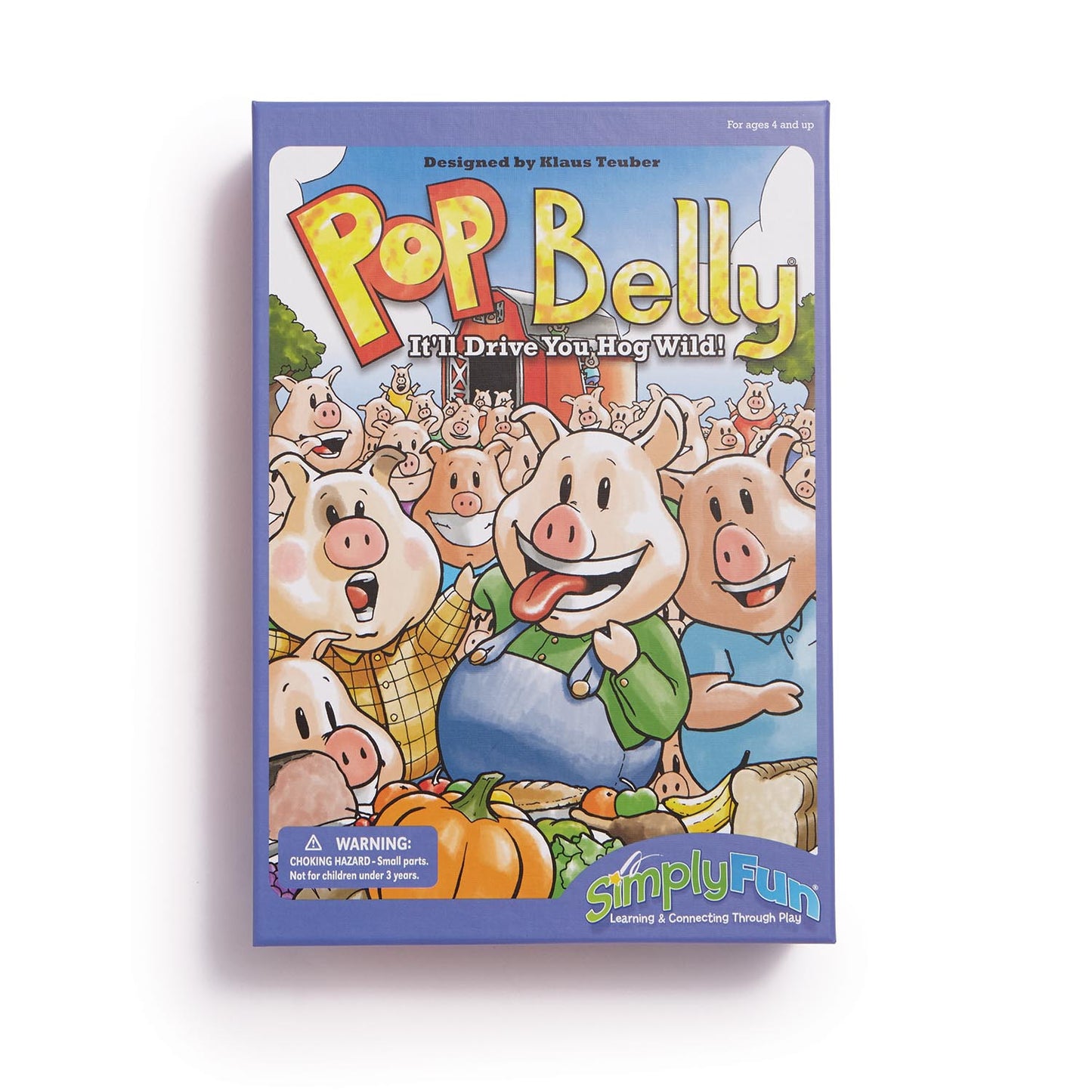
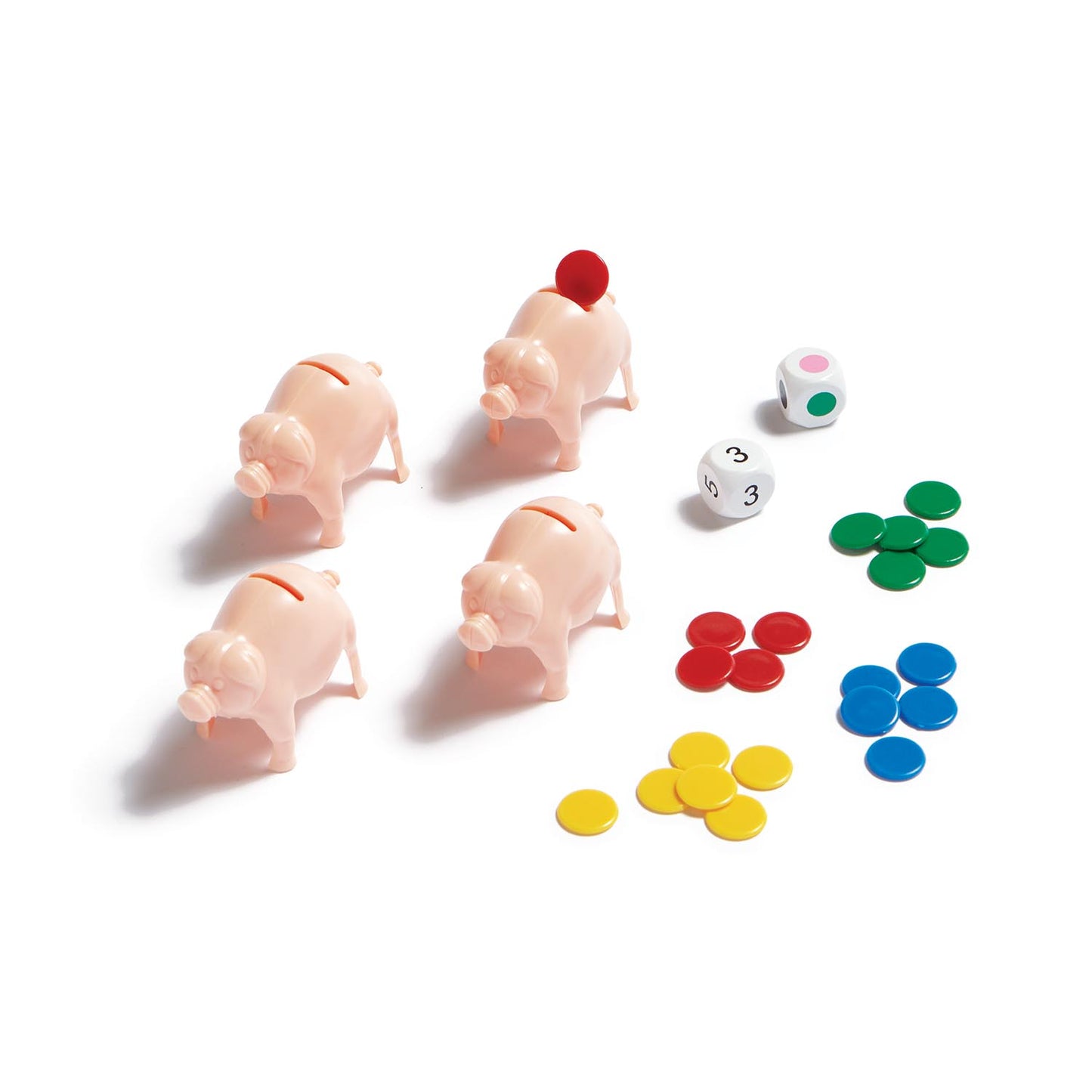
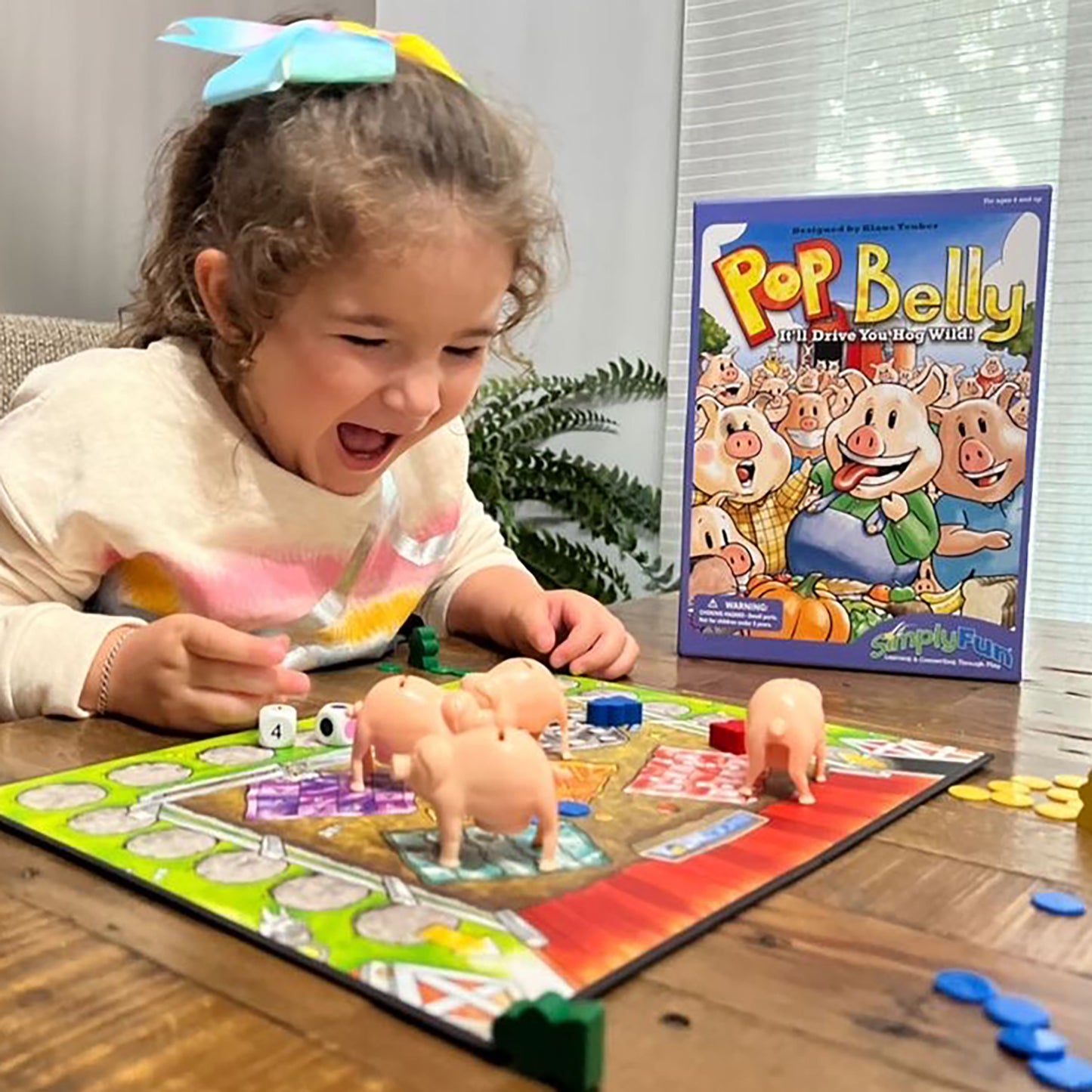
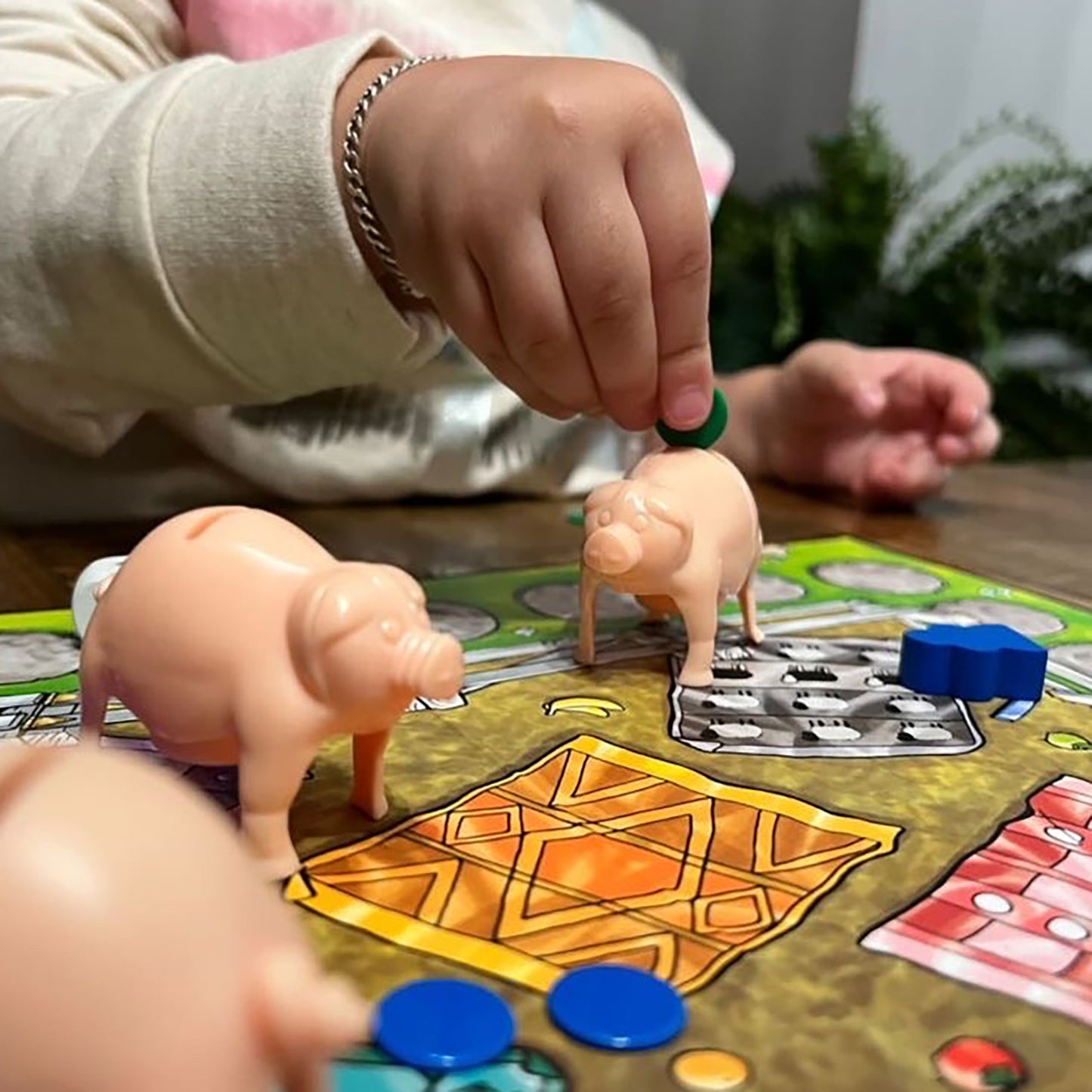
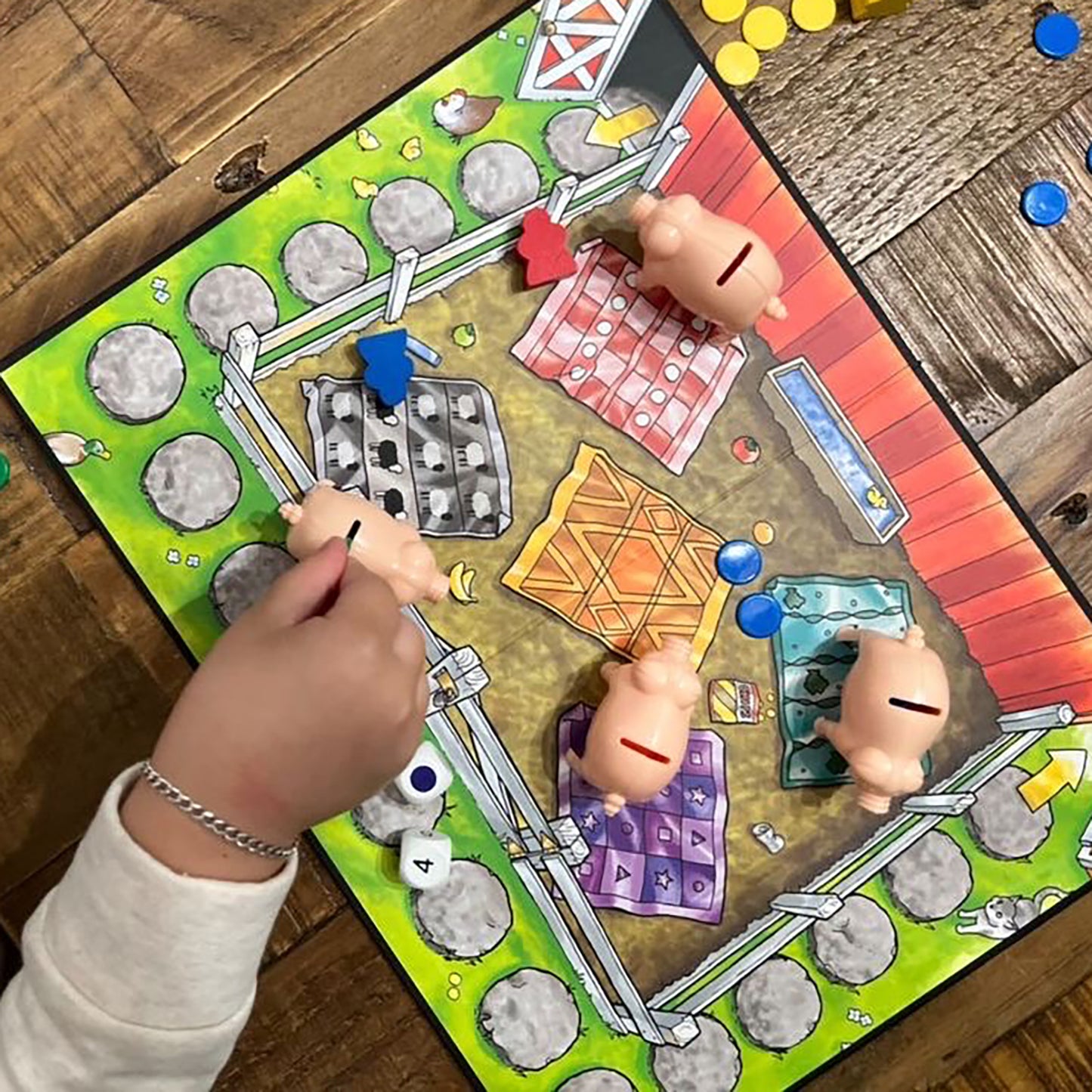
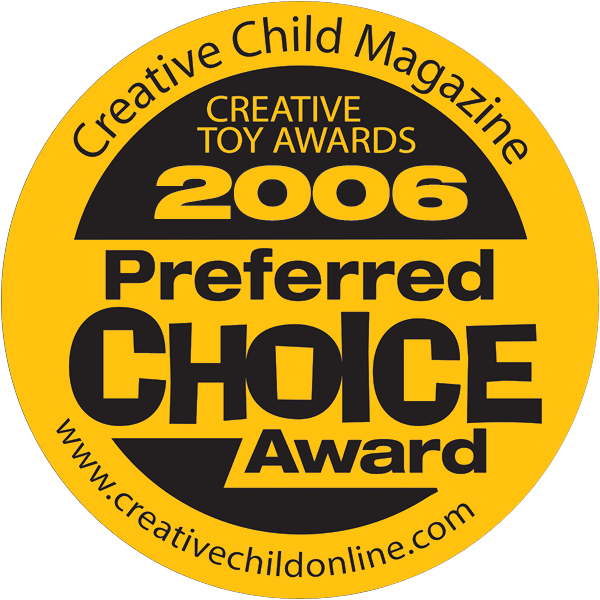
Collapsible content
This is a great strategy game for the whole family: 2 to 4 players ages 4 and up can play.
The game contains five plastic pigs, which each have a different sized belly. The 80 feeding chips come in four colors and the barnyard scene on the gameboard features blankets for the pigs, as well as a scoring track around the outside of the pen.
This is a great game for preschoolers on up. Like all of our games, it promotes skills in several areas: sorting, color recognition, counting, estimating, strategy, memory, fine motor skills... whew! Plus, it's a whole lot of fun!
Snap the bellies into the pigs, and mix them up. Give each player all the chips of one color. Let each player pick a pig to feed two of their chips. The youngest player takes the first turn.
On each turn, roll both the colored and numbered dice. The number shows how many chips must be fed to two different pigs. The first pig can be any pig in the barnyard, but the second must be standing on the blanket of the color rolled on the colored die. How many go to each pig is up to the player, as long as each pig receives at least one chip!
Play continues until a player causes a pig's belly to burst, and all the feed chips fall out. When this happens, the player stops feeding chips immediately. Everyone except the player who caused the pig to pop counts their chips and moves ahead on the scoring track that number of spaces. The player who caused the belly to burst doesn't move forward. Snap the belly back into place and continue with the next player. The first player to exit the barnyard wins the game!
The simple rules and toy-factor of Pop Belly attract young children, but older kids and adults can appreciate the strategy and gameplay elements. This is one the whole family can play together, and everyone will learn something!


Head Start*
Language
- Listening & Speaking
- Shows progress in understanding and following simple and multiple-step directions.
- For non-English-speaking children, progresses in listening to and understanding English.
- Develops increasing abilities to understand and use language to communicate information, experiences, ideas, feelings, opinions, needs, questions and for other varied purposes.
Math
- Numeracy & Operations
- Develops increasing ability to count in sequence to 10 and beyond.
Science*
- Scientific Skills & Methods
- Develops increased ability to observe and discuss common properties, differences and comparisons among objects and materials.
- Begins to participate in simple investigations to test observations, discuss and draw conclusions and form generalizations.
- Begins to describe and discuss predictions, explanations and generalizations based on past experiences.
- Reasoning & Problem Solving
- Grows in recognizing and solving problems through active exploration, including trial and error, and interactions and discussions with peers and adults.
- Develops increasing abilities to classify, compare and contrast objects, events and experiences.
Core Standard*: Science
Science
- Inquiry – Making Observations
- Students learn that scientific investigations involve trying to answer questions by making observations or trying things out, rather than just asking an adult. Children are naturally curious about nearly everything—butterflies and clouds, and why the Moon seems to follow them at night. The essence of this standard is to channel students’ natural curiosity about the world, so that they become better questioners, observers, and thinkers, laying the groundwork for increasing understanding and abilities in science inquiry in the years to come. Grade Level K


Explore
What Does Child Do To Use Skill In The Game?
Players can explore how the pig bellies work.
How Parents Can Assist Learning
Prior to the game being played parents can show children the difference between the bellies and let them explore what happens with the different pigs when they are fed. This will prepare them for the game.
Learning Implications and Educator Support
Prior to the game being played educators can show children the difference between the bellies and let them explore what happens with the different pigs when they are fed. This will prepare them for the game.
Determine
What Does Child Do To Use Skill In The Game?
Players determine how many chips to feed each pig. The also determine how far to move their pawns depending on the number of chips of their color in the pig.
How Parents Can Assist Learning
Determining which pigs to feed requires understanding which are likely to pop. Parents can encourage children to pay close attention to each placement of chips in order to remember which pigs were fed before. This will help the children learn to anticipate which pig may be ready to pop and which are not.
Learning Implications and Educator Support
Determining which pigs to feed requires understanding which are likely to pop. Parents can encourage children to pay close attention to each placement of chips in order to remember which pigs were fed before. This will help the children learn to anticipate which pig may be ready to pop and which are not. Educators can also use Pop Belly to develop counting skills by encouraging children to use one-to-one correspondence, count their own chips and count aloud as they move their pawn.
Compare
What Does Child Do To Use Skill In The Game?
Players compare the color on the dice to the colors of the rugs under the pigs to select one of the pigs to feed. They also compare placement of pawns on the board to see who is ahead.
How Parents Can Assist Learning
No specific adult support required.
Learning Implications and Educator Support
No specific adult support required.
Remember
What Does Child Do To Use Skill In The Game?
Players should try to remember which pigs have small or large bellies, and how many chips have been fed to each.
How Parents Can Assist Learning
Parents can encourage children to pay close attention to each placement of chips in order to remember which pigs were fed before, so the children learn to anticipate which pig may be ready to pop.
Learning Implications and Educator Support
Educators can encourage children to pay close attention to each placement of chips in order to remember which pigs were fed before, so the children learn to anticipate which pig may be ready to pop. To help children remember and predict, have them say aloud each turn which pigs they think are getting ready to pop. Verbalizing is a helpful technique for boosting memory. Also, if you notice that the child is mistaken, you can ask the child to explain why they think a pig is ready to pop and discuss their rationale.
Predict
What Does Child Do To Use Skill In The Game?
If players pay attention, they can make predictions about which pigs may pop based on how many chips have been feed to each pig. They can then avoid feeding the "ready to pop pig" too much.
How Parents Can Assist Learning
Prediction is one of the essential skills being developed and used in Pop Belly. Prior to a child taking his or her turn, the parent can ask the child to predict what pig has the most chips in it. Ask, "Which pig do you think you should feed the least?" If you notice that the child is mistaken, you can ask the child to explain why they think a pig is ready to pop and discuss their rationale.
Learning Implications and Educator Support
Predicting involves skills like analysis, observation, empathy and interpretation. Prior to a child taking their turn, the adult can ask the child to predict what pig has the most chips in it. Ask, "Which pig do you think you should feed the least?" To help children remember and predict, have them say aloud each turn which pigs they think are getting ready to pop. Verbalizing is a helpful technique for boosting memory. Also, if you notice that the child is mistaken, you can ask the child to explain why they think a pig is ready to pop and discuss their rationale.
Plan
What Does Child Do To Use Skill In The Game?
Players can make a plan about which pig to feed, so they avoid popping a pig that has been fed already.
How Parents Can Assist Learning
Parents can encourage children to visualize multiple options for dividing and using Feed Chips prior to determining final choice. Additionally, ask children to say aloud the which pigs they think are ready to pop so that they can focus on feeding other pigs. Help children by asking them to "Wait. Look. Think." This will help with impulsivity and planning. Also, using such cues can give children a model for future play.
Learning Implications and Educator Support
Educators can encourage children to visualize multiple options for dividing and feeding Feed Chips prior to determining final choice. Additionally, ask children to say aloud the which pigs they think are ready to pop so that they can focus on feeding other pigs. Help children by asking them to "Wait. Look. Think." This will help with impulsivity and planning. Also, using such cues can give children a model for future play.
Practice
What Does Child Do To Use Skill In The Game?
Players practice counting up to twenty.
How Parents Can Assist Learning
No specific adult support required.
Learning Implications and Educator Support
Educators can also use Pop Belly to develop counting skills by encouraging children to use one-to-one correspondence, count their own chips and count aloud as they move their pawn.
Solve
What Does Child Do To Use Skill In The Game?
A player matches the number of his or her color feed chips that came out of the pig to solve how many places they move a pawn.
How Parents Can Assist Learning
No specific parent support required unless children have difficulty with one-to-one correspondence when counting spaces to move their pawn based on number of Feed Chips that the have from a "popped" belly. If they do have difficulty, have them place Feed Chips next to the game board such that one chip is next to each of the next spaces that the pawn needs to move. For example, if the child has 3 Feed Chips, there would be one Feed Chip next to three spaces in front of their pawn. Then, have the child count the number of spaces as they move the pawn.
Learning Implications and Educator Support
No specific parent support required unless children have difficulty with one-to-one correspondence when counting spaces to move their pawn based on number of Feed Chips that the have from a "popped" belly. If they do have difficulty, have them place Feed Chips next to the game board such that one chip is next to each of the next spaces that the pawn needs to move. For example, if the child has 3 Feed Chips, there would be one Feed Chip next to three spaces in front of their pawn. Then, have the child count the number of spaces as they move the pawn.
Review
What Does Child Do To Use Skill In The Game?
Players may review if encouraged. See How Parents Can Assist Learning.
How Parents Can Assist Learning
Parents can encourage children to talk about what happened in a previous turn, which pig is now empty, which was fed, etc. This helps children think about the implications for next turns.
Learning Implications and Educator Support
Educators can encourage children to talk about what happened in a previous turn, which pig is now empty, which as fed, etc. This helps children think about the implications for next turns.
Imagine
What Does Child Do To Use Skill In The Game?
Children may use imagination if encouraged. See How Parents Can Assist Learning.
How Parents Can Assist Learning
No specific adult support required, although adults could make up a story as they play about the hungry pigs.
Learning Implications and Educator Support
No specific adult support required, although adults could make up a story as they play about the hungry pigs.
Create
What Does Child Do To Use Skill In The Game?
Children may be creative if encouraged. See How Parents Can Assist Learning.
How Parents Can Assist Learning
No specific adult support required, although adults could make up a story as they play about the hungry pigs.
Learning Implications and Educator Support
No specific adult support required, although adults could make up a story as they play about the hungry pigs.
*Data compiled from CCSSI ELA Standards, WA Science Standards, and Washington Social Studies Standards


Cognitive
Suggestions for How to Modify Play Experience
Simplify the game by having the child feed the number on the die to the pig on the matching blanket. This eliminates the choice of how to split the number given each pig, making it easier for the child to understand.
Don't roll the number die, as children with cognitive delays may not understand the written symbols. Instead, modify the game, so that only the colored die is thrown. Each player adds 2 chips to the pig on the matching colored rug. When a pig pops, the child who pops it gets to remove his colored chips, and the pig is removed from the game board. When the last pig is removed from the board the game is over and all players count their chips.
Communication
Suggestions for How to Modify Play Experience
Comprehension of the rules may be difficult for children with language delays. Act out each step of the game before it is played.
Sensorimotor
Suggestions for How to Modify Play Experience
This game requires refined fine motor skills to be able to get the small chips into the small slot on the pig. This may be too difficult for many children with fine motor delays. Play with a partner, so one child can hold the pig while the other child can assist in putting the pieces in the pig.
Some children may have trouble picking up the chips, but they can orient them over the slot once they pick it up. To help them pick up the chip, wrap some scotch tape around the child's non-dominant finger with the sticky side facing out. The child can then use the sticky edge to pick up the chip and remove and insert the chip into the pig with their other hand.
Social Emotional/Behavioral
Suggestions for How to Modify Play Experience
Children with impulsivity issues may need structure to keep from grabbing the feed chips when the pig's belly pops. Structure the game so each child picks their chips up one player at a time.
Shy children may enjoy adding sound effects as they play the game. For example, say "Oink" each time a chip is fed to a pig, and make a loud pig snorting noise when they pop!
Vision
Suggestions for How to Modify Play Experience
If children have low vision, use a black marker to trace around the slot on each pig. This will increase the contrast and help the child see where the chip goes.
Hearing
Suggestions for How to Modify Play Experience
Hearing is not an issue with this game.
*Data compiled from CCSSI ELA Standards, WA Science Standards, and Washington Social Studies Standards


Autism Strengths & Interests
Short Summary of Strengths & Interests
- Good at spatial reasoning in order to decide if a pig's belly is about to pop.
- Enjoys fine motor activities involving manipulating small objects.
- Likes to analyze situations.
Is good at matching visual items
Is This Game Appropriate? Yes
Description
Children need to match the color on die to the pig on the rug of that same color and put at least one chip in that pig. This is only one aspect of the play sequence, but children who are good at matching can tell other players what pig they have to feed.
Has a good memory for sensory details, including visual, touch, taste and smell
Is This Game Appropriate? Yes
Description
There are several sensory aspects to this game that may appeal to children who like sensory input. First, children note which pigs are filling up. They may attend to the sound of the chips, the size of the different pigs' bellies, and remember which pigs have been fed by other players. Children who have a good memory for these aspects will do well with the game
Has a good memory for words, phrases and dialouge
This game is not appropriate
Has a good memory for pictures, numbers and patterns
This game is not appropriate
Likes to put things in order or a sequence
This game is not appropriate
Learns through visualizing or "replaying" actions in their mind
Is This Game Appropriate? Yes
Description
Children can predict which pigs are getting full by visualizing where other players have placed chips.
Likes activities with rules, such as math and phonics
This game is not appropriate
Is very concrete and literal
Is This Game Appropriate? Yes
Description
Players see the number of chips being placed and note the color of the rugs with the pigs being fed the most. When a pig pops, the chips inside are distributed and players move the number of spaces corresponding to their colored chips in the pig. All of these aspects are very concrete and easy to follow. Children with autism who like these concrete elements may like this game.
Learns in small "chunks" (for example, phone numbers are 3 chunks of number xxx-xxx-xxxx that are combined together)
This game is not appropriate
Is good at nonverbal reasoning and logic
Is This Game Appropriate? Yes
Description
Nonverbal logic is used in deciding which pig to feed. Children use memory and logic to determine which pigs may have more room for chips.
Likes spatial problem solving
Is This Game Appropriate? Yes
Description
Spatial problem solving is involved in Pop Belly. Players need to determine how much space will be filled by the chips that are fed to a given pig and then estimate the space remaining for more chips. This will determine which pigs are selected to receive their chips.
Can read well with good vocabulary, though may not fully comprehend content
This game is not appropriate
Likes to use and has good fine motor skill
Is This Game Appropriate? Yes
Description
Fine motor skills are used to manipulate the chips and feed the pigs, to put the empty pigs and bellies back together, and to move tokens on the board. Children with good fine motor skills will enjoy this aspect of the game.
Likes established routines or set ways of doing things
This game is not appropriate
Likes manipulating, constructing or building things
This game is not appropriate
Likes to use and has good musical abilities
This game is not appropriate
Likes to use and has good drawing skills
This game is not appropriate
Autism Special Considerations
Appears to ignore other's communication and/or has difficulty giving eye contact to a communication partner
Is This Game Appropriate for Child with Characteristic? Yes
Can Child with Characteristic Play Game w/o Modification? Yes
Strategies for Developing Compensatory Skills:
Look at the game instead of each other.
Rather than speak, sing communication between turns or when giving short directions. Music attracts the child's attention and interest.
Use unusual or exaggerated inflection to begin a communication about the game. This attracts the child's attention.
Has difficulty understanding complex verbal directions
Is This Game Appropriate for Child with Characteristic? Yes
Can Child with Characteristic Play Game w/o Modification? No
Strategies for Developing Compensatory Skills:
Break down directions into small steps. Don't go through all the directions at once.
Combine short verbal instructions with visual and physical examples of each step.
Use the online video to illustrate the directions. The visualization assists comprehension.
Use hand-over hand guidance if needed, so children feel the actions as the directions are being given. This helps develop the child's memory for the correct movements. Gradually reduce the support as the game is learned.
Check for comprehension by asking the child to show you what to do next.
Uses vocabulary inaccurately or demonstrates echolalia (repeating another's speech)
Is This Game Appropriate for Child with Characteristic? Yes
Can Child with Characteristic Play Game w/o Modification? Yes
Strategies for Developing Compensatory Skills:
Ask children to name the colors of the pigs they will feed and count their chips as they feed them. This gives children practice in using simple terms and allows adults to observe accuracy of skills.
Respond to immediate echolalia (repeating what was just said) by rephrasing the child's response into a correct format, so the child can hear and repeat that phrase. For example, assume you are playing with a child named Andy and you say, "Your turn," and Andy repeats, "Your turn." You can say, "It's Andy's turn. You say, my turn." This allows the child to hear and repeat the correct response. Eventually, the child will pick up the pattern of response.
Delayed echolalia (repetition of previously heard comments) may have a hidden meaning or association. Look for connection in the phrase used to the current situation. For example, the child says, "After these messages we'll be right back!" Think what the repeated phrase is associated with for the child. Try to interpret what is meant and rephrase it for the child. For example, you might respond by saying, "It sounds like you want a break for a few minutes. Is that what you mean? You can tell me, 'I need a break.'"
Gets stuck repeating a verbal topic or physical actions and/or has difficulty attending to others' actions or topic.
Is This Game Appropriate for Child with Characteristic? Yes
Can Child with Characteristic Play Game w/o Modification? No
Strategies for Developing Compensatory Skills:
The cause-and-effect nature of the game may lead children to want to pop the pig instead of trying NOT to pop the pig. They may consequently forget to split the chips between two pigs. Remind the child at each turn, "You do NOT want the pig to pop."
Remind children about listening and watching others' before making their own comment or action. Especially remind children to watch and remember which pigs have already been fed a lot, as these may be ready to pop.
Use the child's finger to point to what needs attention. They will attend to their finger first, and then the adult can point out the object they are pointing at. For example, point to the die with the child's finger and say, "Four chips." Point to the other die and say, "You must feed the pig on the blue rug."
Extend the child's action to make a correct response. For example, if the child only feeds one pig two chips and stops, say, "You threw a four (point to the 4 on the die) You can feed two more chips to any pig." Reinforce attention and actions by commenting on what was done correctly. For example, "You made a good choice. The pig did not pop!"
Has difficulty producing speech/communication
Is This Game Appropriate for Child with Characteristic? Yes
Can Child with Characteristic Play Game w/o Modification? Yes
Strategies for Developing Compensatory Skills:
Use augmentative communication, such as picture cards. For example, a picture of person pointing to another person means "your turn."
Use gestures and sign language to illustrate actions or concepts. For example, use the sign for 'finished' (turn two hands to face down, then spread hands outward from the center of the body), point to the next player and say, "I'm done. It's your turn." The signs and gestures add a visual component to support understanding.
Encourage children to comment after their turn. "What did you just do with your chips?"
Provide at least 10 seconds wait time for the child to process or produce responses. It may take longer to formulate a thought or response for children with special needs.
Has difficulty sequencing multi-step actions and/or doing complex abstract tasks
Is This Game Appropriate for Child with Characteristic? Yes
Can Child with Characteristic Play Game w/o Modification? No
Strategies for Developing Compensatory Skills:
Use a verbal and/or physical prompt for each step of a turn. After several turns, wait and see what the child can do independently. Provide additional prompts as needed until the child can complete a turn independently.
Demonstrates difficulty initiating and maintaining social interactions
Is This Game Appropriate for Child with Characteristic? Yes
Can Child with Characteristic Play Game w/o Modification? No
Strategies for Developing Compensatory Skills:
Develop a social story to be read at the start of a game. A social story is a short booklet that illustrates how a child can use positive social skills. It includes two to five descriptive statements and a directive statement. For example: "When I watch others, I will know when it is my turn. Others like me when I take turns. I will watch what others do with their pieces and listen to what they say. Others like it when I talk about the game." Add photos or drawings of the child doing the actions described in the story.
Role play commenting on another player's turn. For instance, "Oh, too bad. It popped!."
Encourage discussion of which pigs may be ready to pop in between turns. Although, typically this would not be a good strategy in a competitive game, the purpose here is to encourage conversation among players.
Acts out or demonstrates avoidance behaviors when frustrated, overwhelmed, or needs more sensory input.
Is This Game Appropriate for Child with Characteristic? Yes
Can Child with Characteristic Play Game w/o Modification? No
Strategies for Developing Compensatory Skills:
Reduce extraneous noise or allow the child to wear head phones or ear plugs if loud sounds cause anxiety.
A weighted vest worn during the game may provide additional pressure input and thus reduce fidgeting due to sensory needs. Pressure can be calming when used for no more than 20 minutes at a time.
Practice a phrase to ask for help and role play situations in the game where it is needed.
Provide techniques for self-calming, such as holding a special toy.
Allow time for movement. For example, a child who needs to move frequently can be given an opportunity to 'celebrate' their turn by running around the table or jumping up and down 10 times.
Has short attention span for non-preferred activities
Is This Game Appropriate for Child with Characteristic? Yes
Can Child with Characteristic Play Game w/o Modification?
Strategies for Developing Compensatory Skills:
Provide a break when needed.
Use "when...then" phrases. For example, "When you take your turn, then I'll let you play with your toy."
Frequently remind the child of the goal of the game.
Incorporate a motivating activity as part of the play. For example, each player gets to manipulate a fun 'fidget' toy, such as a stress ball or squeeze toy.
Needs sameness or consistent routines and/or has difficulty with transitions from one activity to another
Is This Game Appropriate for Child with Characteristic? Yes
Can Child with Characteristic Play Game w/o Modification? No
Strategies for Developing Compensatory Skills:
Play games at the same time every day, so the child anticipates the game routine.
Change the location of the game, so the child may play in different rooms, at the table, or on the floor. This will build tolerance for variation.
Prepare the child ahead time for the introduction of a new game. Talk about aspects that will be motivating for the child, and let them explore the parts of the game before setting out the whole game.
Provide a structure for placement of game pieces that can be the same each time the game is played. For example, have a specific location for where the board goes, the pieces, etc. Provide choices for how the child can be involved in set up or clean up. For example, you might ask, "Do you want to put the pigs together or set up the board?"
Involve the child verbally and with actions for the transition to the game table or at the end of game play. For example, you might say, "Let's look at the pictures on the game box and guess what it is about." Use an object cue. Let the child hold an object from the game or activity you want to introduce prior to the transition. For example, if you were intending to play Pop Belly you would hand the child a pig from the game and say, "Look here is a pig. Let's see what we do with it!"
Has difficulty understanding others' feelings, intentions, and the reasons for others' actions.
Is This Game Appropriate for Child with Characteristic? Yes
Can Child with Characteristic Play Game w/o Modification? Yes
Strategies for Developing Compensatory Skills:
Model and point out what others are feeling and comment on their facial expressions or words.
Discuss what causes feelings in others. For example, "You are happy because you get to move your piece. But, look at Joe's face. He is not happy because he popped the pig."
Ask child to explain their own feelings and intentions. "Why did you pick that pig?" If they cannot respond, give a choice. Did you think it was empty or full?"
Ask child to explain why other players did specific actions in the game. Why questions are difficult for children to answer. You may want to provide a model. For example, "I wonder why Joe picked that pig to feed. I'll bet he knew it hadn't been fed yet."
*Data compiled from CCSSI ELA Standards, WA Science Standards, and Washington Social Studies Standards


Extra Ways to Play the Game
Change the focus of the game by trying to pop the pig's belly. When you pop the belly of the pig, everyone counts the number of feed chips of their color in the pig. Someone writes down the number for each player. The first person to 100 wins the game.
Materials Needed
No additional materials needed.
Developmental Benefits
This modification raises the level of the game, as children need to count to higher numbers and add numbers. If children are not be able to add numbers to 100, adults can help.
Extra Ways to Play the Game
Let children pretend to be in a carnival game called "Where's the Fat Pig?" Give each player five chips of the color of their choice. The "farmer" puts one chip of a different color into one of 3 pigs that are in a line. He tells the other players to "watch carefully." They then quickly switch the pigs all around many times. Each child then places from one to five chips in front of the pig they think has the food inside. The farmer then shakes each pig to see which one has the food. The farmer takes all chips laid in front of each empty pig, and gives any child who guessed correctly an equal number of their colored chips. The first child to get 10 chips wins.
Materials Needed
No additional materials needed.
Developmental Benefits
This old fashioned game requires attention and focus as well as visual tracking skills. Tracking skills are important for reading.
Extra Ways to Play the Game
Line up the pigs and let each player choose a pig. Each player also bets which pig will pop first. Each player adds a chip in turn to their pig. When a pig pops, give a point to each player who was correct. The first person to get 10 points wins.
Materials Needed
No additional materials needed.
Developmental Benefits
This modification requires children to think about how much to bet. They could win many chips, but they could also lose all of their chips. Children learn to not be impulsive, but plan ahead. They also practice focusing on and tracking an object. This is an important skill for reading. Children will also practice counting.
Extra Ways to Play the Game
Children can make up stories about the hungry pigs. Let them build a pig pen from blocks and introduce a toy farmer character. For instance, the farmer can keep telling the pigs not too eat to much or they will get sick and "Pop." When the farmer moves away, the pigs can sneak their food.
Materials Needed
No additional materials needed.
Developmental Benefits
Children learn to work together and use objects to create a series of actions to make a story. Dramatic play also builds social skills.
*Data compiled from CCSSI ELA Standards, WA Science Standards, and Washington Social Studies Standards
- Choosing a selection results in a full page refresh.
- Opens in a new window.








